The character of the trickster fox is everywhere in folktales from around the world. Sometimes he’s evil, but most often he’s a trickster, known for being cunning, wily, and resourceful. Their first mention comes in the fables of Aesop, in 4 BC, and these are carried forward through the 12th century when the character of Reynard emerges.
Reynard is a trickster red fox. The stories that came out starting in the 12th century place him in medieval literature as a parody of the courtly love stories. Reynard is treated in the tales as though he is human and lives in a world with other talking animals. The situations in the stories are set up such that people reading or hearing them can make parallels with their own lives.
When his time for trickery is up, one of the standard situations in the stories would be an elaborate funeral, attended by friends and enemies. The enemies deliver funeral orations full of insincerity that are then acted upon by the not-so-dead Reynard as he takes his revenge.
In the marginalia of a 13th-century Book of Hours held in the Walters Art Museum in Baltimore, there’s a procession of Reynard’s friends and enemies going to his funeral. What’s of interest to us is that his animal associates are all playing musical instruments as they process across the bottom of the pages.
The Walters MS W. 102 was created in England at the end of the 13th century for a now-unknown patron. The book is incomplete and, over time, has been misbound, with sections out of order. These books of prayers for the canonical hours were often lavishly illustrated, and this one is no exception. On the first page of the manuscript we can see not only lavish use of red and black ink but also blue, grey and white ink in the initials and the decoration.
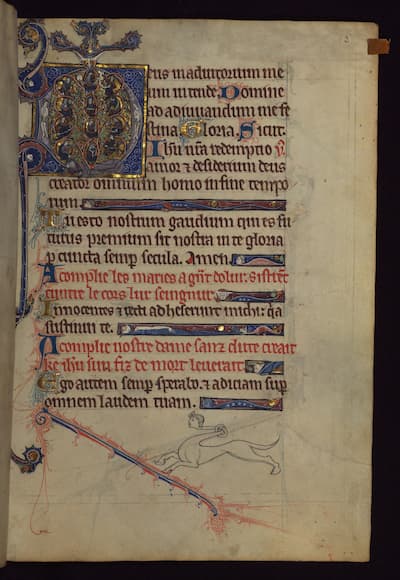
first page of the Book of Hours, ca. 1300 (Baltimore: Walters Art Museum, MS W. 102), fol. 2r
Gold has been applied and empty spaces are filled with illustrations, such as in the capital “D” initial and in the bottom margin. The illustration in the letter is that of the Tree of Jesse, depicting the ancestors of Jesus.
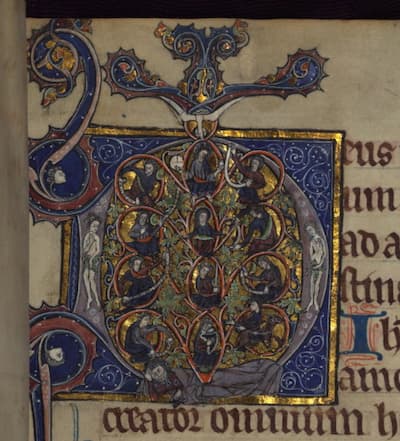
The initial “D” from ‘Deus, in adiutorium meum intende’, the introductory prayer for every hour (Baltimore: Walters Art Museum, MS W. 102), fol. 7
At folio 73, the procession for Reynard’s funeral begins, simply with a single picture at the bottom of the page. In the world of Reynard, his friends all have names: Reynard the Fox, Isengrim the Wolf, Tibert the Cat, King Noble the Lion, Bruin the Bear, Grimbard the Badger, Baldwin the Ass, Hirsent the She-wolf, Kyward the Hare, Chanticleer the Cock, Bellin the Ram, and Martin the Ape and many of them are in this procession playing musical instruments.
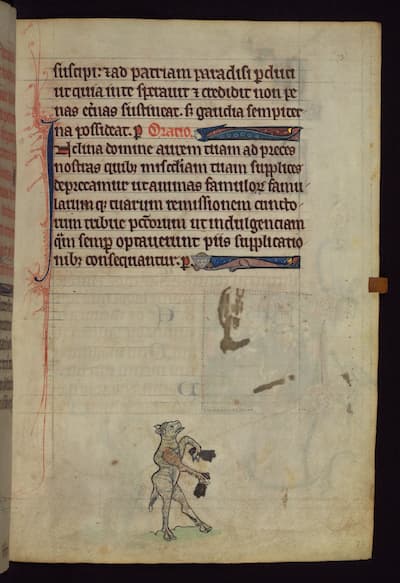
Book of Hours, ca. 1300 (Baltimore: Walters Art Museum, MS W. 102), fol. 73r
Anonymous: Amis, amis, Trop me laissiez en estrange païs [Rotrouenge, 13th century] (Alejandro Tonatiuh Hernández, fiddle; Pepe Morales Luna, citole)
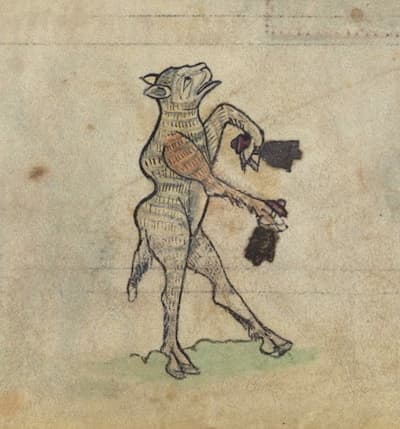
Sheep ringing bells, detail from fol. 73r

Bull blowing a horn, detail from fol. 74r
Anonymous / Hoxbro / Lacey: Sancta mater graciæ – Dou way, Robin (arr. P. Høxbro and G. Lacey) (Genevieve Lacey, recorder; Poul Hoxbro, pipe and tabor)

Horse playing a pipe and tabor, detail from fol. 74v

Baldwin the Ass playing a pipe and bell, detail from fol. 75r

Dog playing bagpipes, detail from fol. 75v
Note that the dog is playing bagpipes that seem to have a mouse head. Regular bagpipes used to be made out of the body of a sheep, but this instrument seems much simpler.
Anonymous: Sic mea fata canendo solor [Carmina Burana (CB) 116, Benediktbeuern MS, 13th century] (Augsburg Early Music Ensemble)
The two animals carrying Reynard’s bier are split across a page opening, with Brchimer the Stag on the left and Tibert the Cat on the fight. Reynard is covered with a blue cloth, with only his head and tail visible.
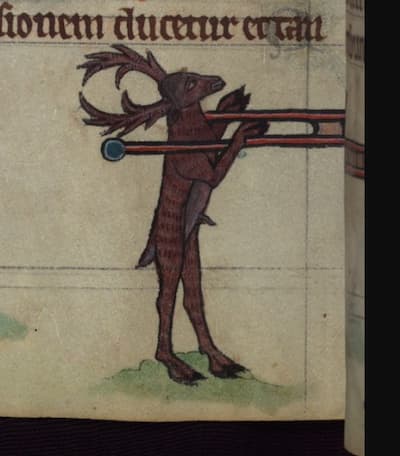
Reynard’s bier, left side, fol. 76v
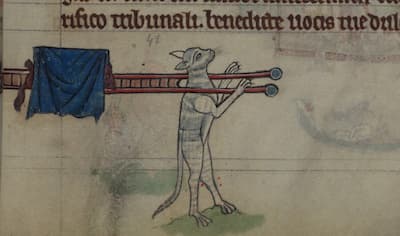
Reynard’s bier, right side, fol. 77r

Brechimer the Stag and Tibert the Cat carrying Reynard the Fox’s bier,
detail from fol. 76v and fol. 77r. (composite image)

Tibert the Cat playing a square drum, detail from fol. 78v
Anonymous: Qui loiaument sert s’amie [Motet, 13th Century] (Alla Francesca)

Bruin the Bear blowing a cornetto, detail from fol. 79v
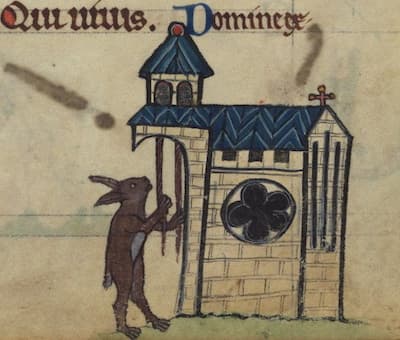
Kyward the Hare tolling church bells, detail from fol. 81r
Philippe de Vitry: Vos quid admiramini / Gratissima (Musica Nova)
As part of the images of animals in the marginalia being a vision of the world turned upside down, this funerary procession is also backwards. Instead of starting with the Ram and his bell at the beginning, we should turn to the end of the procession to see the Hare tolling the church bells at the beginning. When we start this procession on folio 73r, we are really at the end of the parade. There are other animals in the procession but who do not carry musical instruments: Reynard’s principal enemy, Ysengin the Wolf appears as a bishop. Chanticleer the Cock carries the incense censor. A Boar is shown with a scythe, preparing the ground for the grave.
What every reader would know is what happens next: Reynard leaps out alive and revenges himself on his enemies (again). Reynard is the clever peasant-hero and his enemies are representatives of the church or the wealthy, and Reynard will always win.
For more of the best in classical music, sign up to our E-Newsletter




